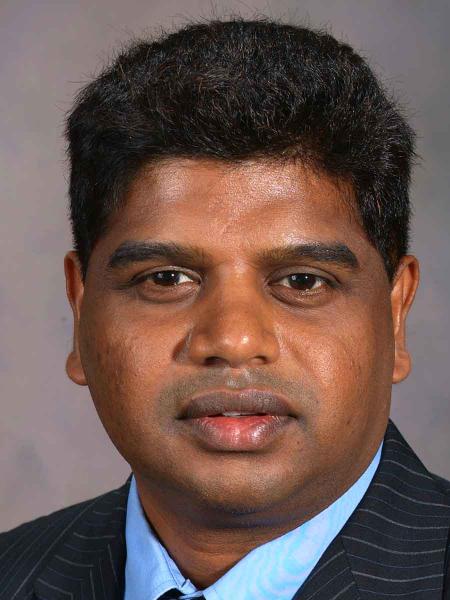Subramaniam Sathivel
 Professor
Professor
Address:
149 E. B. Doran Building, LSU Baton Rouge, LA 70803
Email Address:
Office Phone:
Phone: (225) 578-0614 / Fax: (225) 578-3492
Research Interests
Food engineering aspects with emphasis on:
- design and development of the unit operation for food processing
- processing food materials into value added- products
- preservation and packaging of foods which include coating, edible film, and micro-encapsulation
- thermal, rheological, and functional properties of functional ingredients and foods,
- utilization of agricultural processing wastes
- optimization of processing conditions, and
- development of non-food materials from biological wastes including bio-diesel
Teaching Responsibilities
BE 2352: Quantitative Biology in Engineering (Fall)
Educational Background
Doctor of Philosophy in Food Science (Food Engineering), Department of Food Science, Louisiana State University.
Master of Science in Food Process Engineering, Department of Food Science and Technology, University of Reading, United Kingdom.
Bachelor of Science in Agriculture (Agricultural Engineering) (Honors, Upper Division), Department of Agricultural Engineering, University of Peradeniya, Sri Lanka.
Selected Publications
1. Sathivel, S., W. Prinyawiwatkul, I.I. Negulescu, and J. M. King. Determination of melting points, specific heat and enthalpy of catfish oil during different processing steps. Journal of the American Oil Chemists' Society. 85: 291-296. (2008).
2. Sathivel, S., J. Huang, and W. Prinyawiwatkul. Thermal properties and applications of the Arrhenius equation for evaluating viscosity and oxidation rates of unrefined pollock oil. Journal of Food Engineering. 84:187-193. (2008).
3. Sathivel, S., Q Liu, J. Huang, and W. Prinyawiwatkul. The influence of chitosan glazing on the quality of skinless pink salmon (Oncorhynchus gorbuscha) fillets during frozen storage. Journal of Food Engineering. 83:366-373. (2007)
4. Sathivel, S., P. J. Bechtel,. and W. Prinyawiwatkul. Physicochemical and Rheological Properties of Salmon Protein Powders. International Journal of Food Engineering. 2:2, Article 3. http://www.bepress.com/ijfe/vol2/iss2/art3. (2006).
5. Sathivel, S. and P. J. Bechtel. Properties of Soluble Protein Powders from Pollock. International Journal of Food Science and Technology. 41: 520-529. (2006).
6. Nadarajah, K., W. Prinyawiwatkul, H. K. No, and S. Sathivel. Sorption Behavior of Crawfish Chitosan Films as Affected by Chitosan Extraction Processes and Film Casting Solvents. Journal of Food Science. 71(2):E033-039. (2006).
7. Sathivel, S. Chitosan and Protein Coatings Affect Yield, Moisture Loss and Lipid Oxidation of Pink Salmon (Oncorhynchus gorbuscha) Fillets During Frozen Storage. Journal of Food Science. 70: E455-E459 (2005).
8. Sathivel, S., P. J. Bechtel, J. Babbitt, W. Prinyawiwatkul, and I. I. Negulescu. Functional, Thermal, and Rheological Properties of Alaska White Fish Meal Made from Processing Byproducts. Journal of Aquatic Food Product Technology. 14(4):5-22 (2005).
9. Sathivel, S., S, Smiley, W. Prinyawiwatkul, and P. J. Bechtel. Functional and Nutritional Properties of Red Salmon (Oncorhynchus nerka) Enzymatic Hydrolysates. Journal of Food Science. 70: C401-C406 (2005).
10. Sathivel, S. Thermal and Flow Properties of Oils from Salmon Head. Journal of the American Oil Chemists' Society. 82: 147–151 (2005).
11. Sathivel, S., P. J. Bechtel, J. Babbitt, W. Prinyawiwatkul, and M. Patterson. Functional, Nutritional, and Rheological Properties of Protein Powders from Arrowtooth Flounder and their Application in Mayonnaise. Journal of Food Science. 70:E57-E63 (2005).
12. Sathivel, S., P. J. Bechtel, J. Babbitt, W. Prinyawiwatkul, I. I. Negulescu, and K.D. Reppond. Properties of Protein Powders from Arrowtooth Flounder (Atheresthes stomias) and Herring (Clupea harengus) Byproduct. Journal of Agricultural and Food Chemistry. 52:5040-5046 (2004).
13. Sathivel, S. and W. Prinyawiwatkul. Adsorption of Free Fatty Acids in Crude Catfish Oil onto Chitosan, Activated Carbon, and Activated Earth: A Kinetics Study. Journal of the American Oil Chemists' Society. 81:493-496 (2004).
14. Sathivel, S., W. Prinyawiwatkul, I. I. Negulescu, J.M. King, and B.F.A. Basnayake. Thermal Degradation of Fatty Acids and Catfish and Menhaden Oils at Different Purification Steps. Journal of the American Oil Chemists' Society. 80: 1131-1134 (2003).
15. Sathivel, S., P. J. Bechtel, J. Babbitt, S. Smiley, C. Crapo, K.D. Reppond, and W. Prinyawiwatkul. Biochemical and Functional Properties of Herring (Clupea harengus) Byproduct Hydrolysates. Journal of Food Science. 68: 2196-2200 (2003).
16. Sathivel, S., W. Prinyawiwatkul, I. I. Negulescu, J.M. King, and B.F.A. Basnayake. Effects of Purification Process on the Rheological Properties of Catfish Oil. Journal of the American Oil Chemists' Society. 80:829-832 (2003).
17. Sathivel, S., W. Prinyawiwatkul, J.M. King, C.C. Grimm, and S. Lloyd. Oil Production from Catfish Viscera. Journal of the American Oil Chemists' Society. 80:377-382 (2003).
18. Sathivel, S., W. Prinyawiwatkul, J.M. King, C.C. Grimm, and S. Lloyd. Microwave- Assisted Catfish Liver Oil Extraction and Fatty Acid Analysis. Journal of the American Oil Chemists' Society. 80:15-20 (2003).
19. Prinyawiwatkul, W., V. Suvanich, R.W. Harrison, J. M. King, S. Sathivel, K. Pacheco, S. Rout, K. Nadarajah, and S. Sonti. Value-Added from Crawfish and Catfish. Louisiana Agriculture. Fall issue. 20-
21(2002).
20. Sathivel, S., W. Prinyawiwatkul, C.C. Grimm, J.M. King, and S. Lloyd. FA Composition of Crude Oil Recovered from Catfish Viscera. Journal of the American Oil Chemists' Society. 79: 989-992 (2002).
21. P. J. Bechtel, Chantarachoti, J. A. C. M. Oliveira, and S. Sathivel. Characterization of Soluble and Insoluble Protein Fractions from Immature Alaska Walleye Pollock (Theragra chalcogramma) roe. Journal of Food Science. 2007. (Accepted).
22. Sathivel, S. and P. J. Bechtel. A comparison of Physical and Rheological Properties of Arrowtooth Flounder Protein Made Using Three Different Extra